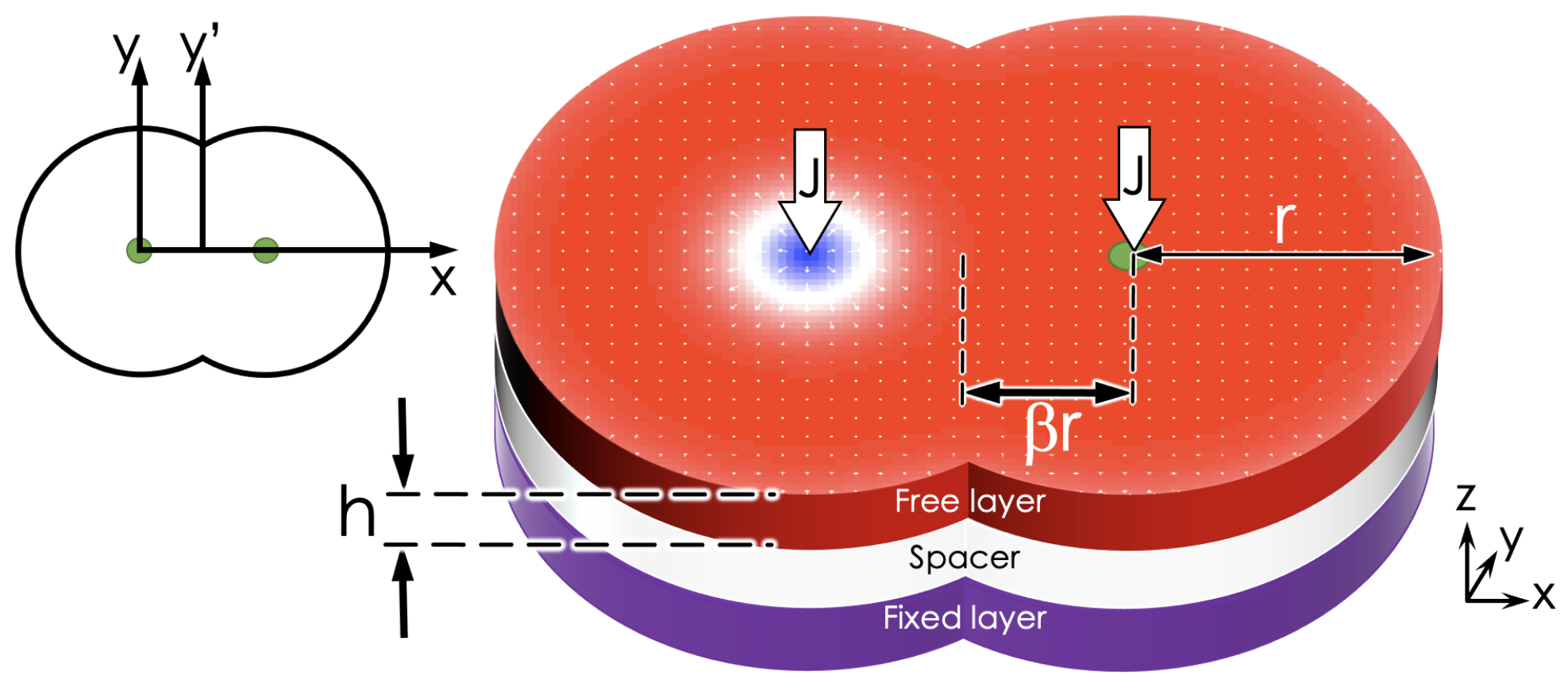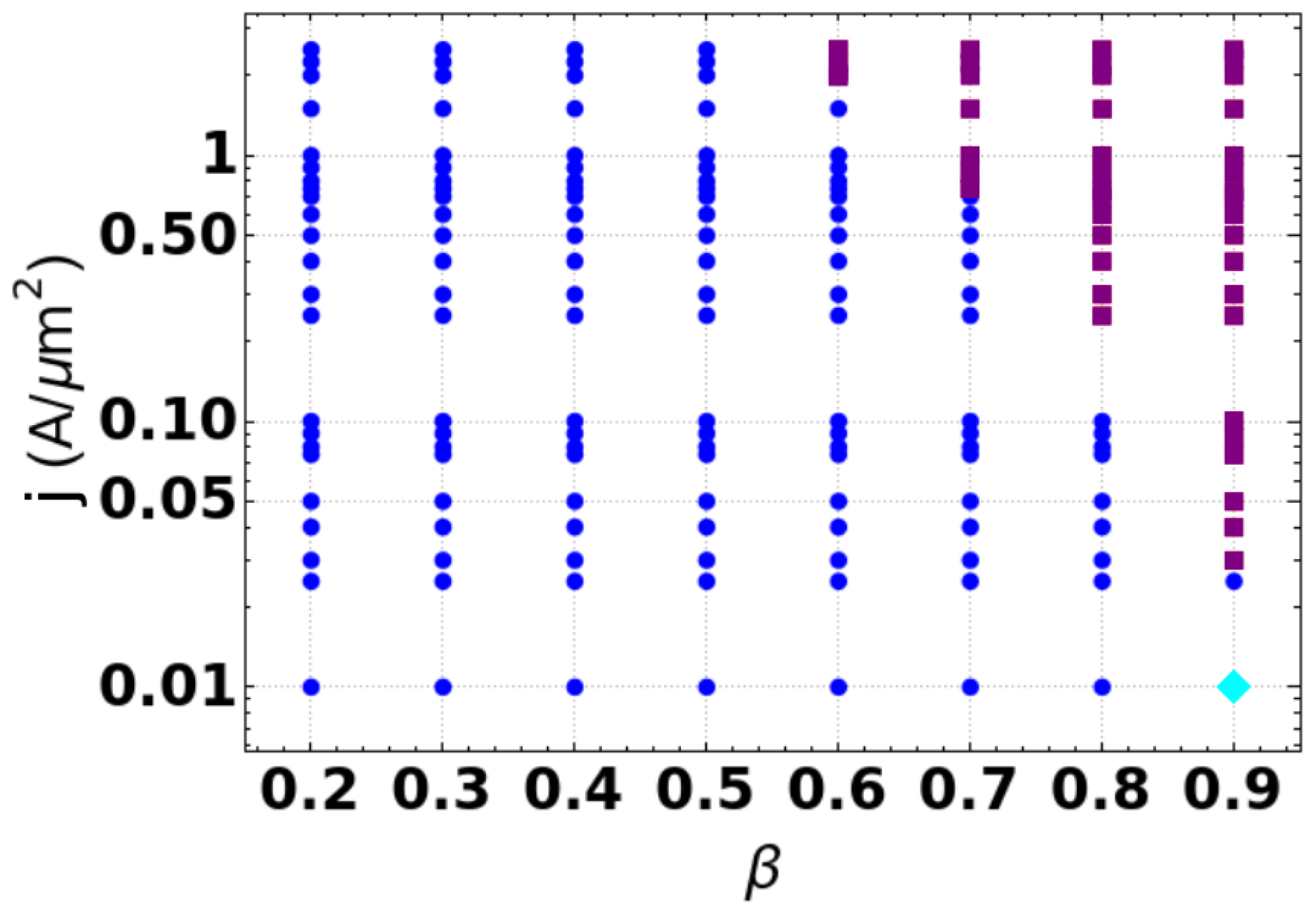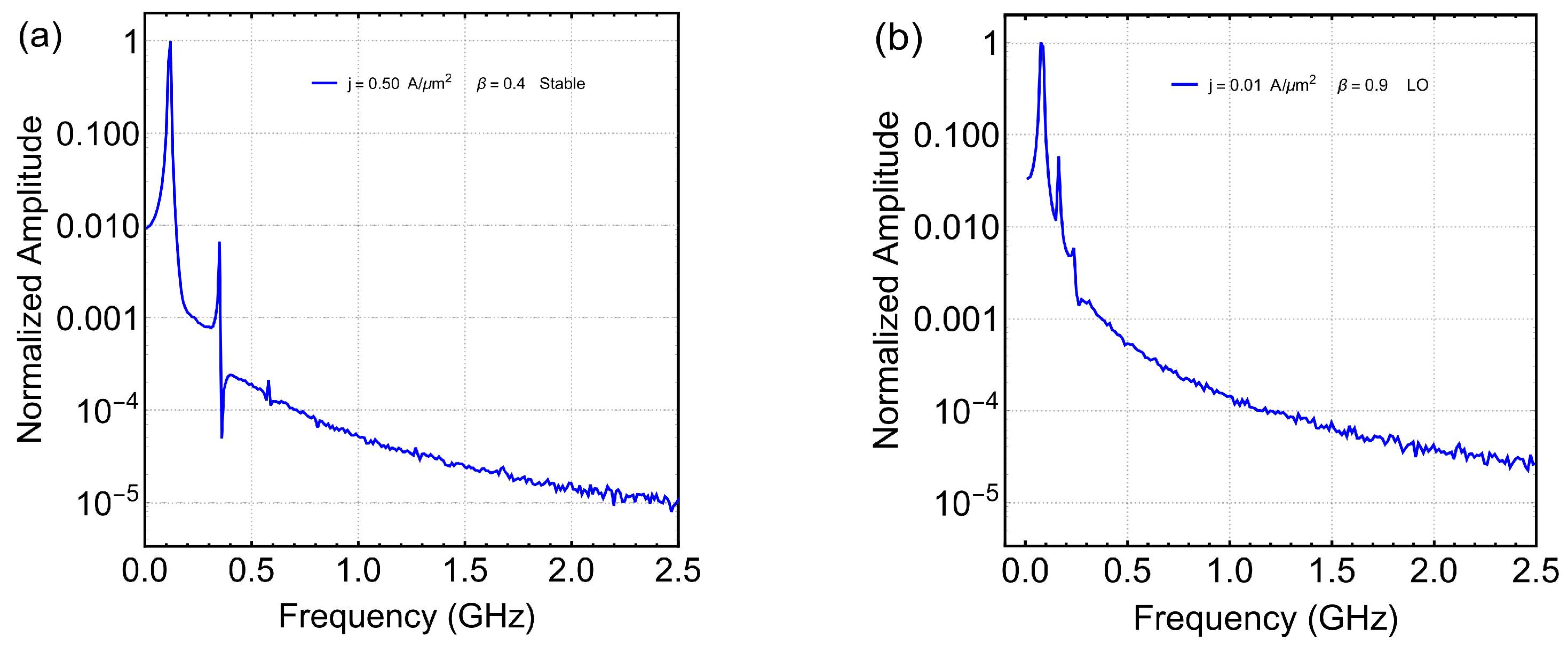Skyrmion Dynamics in a Double-Disk Geometry under an Electric Current
Abstract
:1. Introduction
2. Theoretical Model
2.1. Some Insight into Symmetric and Asymmetric Circular STNO-Like Devices
2.2. Two-Disk STNO-Like Device
3. Results and Discussion
3.1. Equilibrium States without Current
3.2. Effect of the Current: State Diagram
3.2.1. Annihilation Regime
3.2.2. Oscillatory Regimes
4. Conclusions
Supplementary Materials
Author Contributions
Funding
Institutional Review Board Statement
Informed Consent Statement
Data Availability Statement
Conflicts of Interest
Abbreviations
| DMI | Dzyaloshinskii–Moriya Interaction |
| STNO | Spin Torque Nano-Oscillator |
| LLGS | Landau–Lifshitz–Gilbert–Slonczewski |
| STT | Spin Transfer Torque |
| J | Electric current density |
| SD | State Diagram |
| FFT | Fast Fourier Transform |
References
- Rajaraman, R. Solitons and Instantons: An Introduction to Solitons and Instantons in Quantum Field Theory; North-Holland: Amsterdam, The Netherlands, 1984. [Google Scholar]
- Nagaosa, N.; Tokura, Y. Topological properties and dynamics of magnetic skyrmions. Nat. Nanotechnol. 2013, 8, 899. [Google Scholar] [CrossRef] [PubMed]
- Fert, A.; Reyren, N.; Cros, V. Magnetic skyrmions: Advances in physics and potential applications. Nat. Rev. Mater. 2017, 2, 17031. [Google Scholar] [CrossRef]
- Liang, D.; DeGrave, J.P.; Stolt, M.J.; Tokura, Y.; Jin, S. Current-driven dynamics of skyrmions stabilized in MnSi nanowires revealed by topological Hall effect. Nat. Commun. 2015, 6, 8217. [Google Scholar] [CrossRef] [PubMed]
- Büttner, F.; Moutafis, C.; Schneider, M.; Krüger, B.; Günther, C.M.; Geilhufe, J.; Korff Schmising, C.V.; Mohanty, J.; Pfau, B.; Schaffert, S.; et al. Dynamics and inertia of skyrmionic spin structures. Nat. Phys. 2015, 11, 225. [Google Scholar]
- Napoli, G.; Vergori, L. Extrinsic Curvature Effects on Nematic Shells. Phys. Rev. Lett. 2012, 108, 207803. [Google Scholar] [CrossRef]
- Tejo, F.; Toneto, D.; Oyarzún, S.; Hermosilla, J.; Danna, C.S.; Palma, J.L.; da Silva, R.B.; Dorneles, L.S.; Denardin, J.C. Stabilization of Magnetic Skyrmions on Arrays of Self-Assembled Hexagonal Nanodomes for Magnetic Recording Applications. ACS Appl. Mater. Interfaces 2020, 12, 53454. [Google Scholar]
- Rutonjski, M.S.; Pantic, M.R.; Pavkov-Hrvojevic, M.V. Effects of frustation and Dzyaloshinskii-Moriya interaction on the spin-1/2 anisotropic Heisenberg antiferromagnet with the application to La2CuO4. Phys. Status Solidi (B) Basic Solid State Phys. 2020, 258, 2000508. [Google Scholar] [CrossRef]
- Sapozhnikov, M.V. Skyrmion lattice in a magnetic film with spatially modulated material parameters. J. Magn. Magn. Mater. 2015, 396, 338–344. [Google Scholar] [CrossRef]
- Tomasello, R.; Guslienko, K.Y.; Ricci, M.; Giordano, A.; Barker, J.; Carpentieri, M.; Chubykalo-Fesenko, O.; Finocchio, G. Origin of temperature and field dependence of magnetic skyrmion size in ultrathin nanodots. Phys. Rev. B 2018, 97, 060402. [Google Scholar] [CrossRef]
- Wang, X.S.; Yuan, H.Y.; Wang, X.R. A theory on skyrmion size. Comm. Phys. 2018, 1, 31. [Google Scholar] [CrossRef]
- Mühlbauer, S.; Binz, B.; Jonietz, F.; Pfleiderer, C.; Rosch, A.; Neubauer, A.; Georgii, R.; Böni, P. Skyrmion Lattice in a Chiral Magnet. Science 2009, 323, 915. [Google Scholar] [CrossRef] [PubMed]
- Jonietz, F.; Mühlbauer, S.; Pfleiderer, C.; Neubauer, A.; Münzer, W.; Bauer, A.; Adams, T.; Georgii, R.; Böni, P.; Duine, R.A.; et al. Spin Transfer Torques in MnSi at Ultralow Current Densities. Science 2010, 330, 1648. [Google Scholar] [CrossRef] [PubMed] [Green Version]
- Nakajima, T.; Oike, H.; Kikkawa, A.; Gilbert, E.P.; Booth, N.; Kakurai, K.; Taguchi, Y.; Tokura, Y.; Kagawa, F.; Arima, T.-H. Skyrmion lattice structural transition in MnSi. Sci. Adv. 2017, 3, e160256. [Google Scholar] [CrossRef] [PubMed]
- Lin, S.-Z.; Reichhardt, C.; Saxena, A. Manipulation of skyrmions in nanodisks with a current pulse and skyrmion rectifier. Appl. Phys. Lett. 2013, 102, 222405. [Google Scholar] [CrossRef]
- Komineas, S.; Papanicolaou, N. Skyrmion dynamics in chiral ferromagnets. Phys. Rev. B 2015, 92, 064412. [Google Scholar] [CrossRef]
- Garcia-Sanchez, F.; Sampaio, J.; Reyren, N.; Cros, V.; Kim, J.-V. A skyrmion-based spin-torque nano-oscillator. New J. Phys. 2016, 18, 075011. [Google Scholar] [CrossRef]
- Zhang, S.; Wang, J.; Zheng, Q.; Zhu, Q.; Liu, X.; Chen, S.; Jin, C.; Liu, Q.; Jia, C.; Xue, D. Current-induced magnetic skyrmions oscillator. New J. Phys. 2015, 17, 023061. [Google Scholar] [CrossRef]
- Guo, J.H.; Xia, J.; Zhang, X.C.; Pong, P.W.T.; Wu, Y.M.; Chen, H.; Zhao, W.S.; Zhou, Y. A ferromagnetic skyrmion-based nano-oscillator with modified profile of Dzyaloshinskii-Moriya interaction. J. Magn. Magn. Mater. 2020, 496, 165912. [Google Scholar] [CrossRef]
- Jin, C.; Ma, Y.; Song, C.; Xia, H.; Wang, J.; Zhang, C.; Zeng, Z.; Wang, J.; Liu, Q. High-frequency spin transfer nano-oscillator based on the motion of skyrmions in an annular groove. New J. Phys. 2020, 22, 033001. [Google Scholar] [CrossRef]
- Gobel, B.; Henk, J.; Mertig, I. Forming individual magnetic biskyrmions by merging two skyrmions in a centrosymmetric nanodisk. Sci. Rep. 2019, 9, 9521. [Google Scholar] [CrossRef]
- Kravchuk, V.P.; Rößler, U.K.; Volkov, O.M.; Sheka, D.D.; Brink, J.V.; Makarov, D.; Fuchs, H.; Fangohr, H.; Gaididei, Y. Topologically stable magnetization states on a spherical shell: Curvature-stabilized skyrmions. Phys. Rev. B 2016, 94, 144402. [Google Scholar] [CrossRef]
- Yang, J.; Abert, C.; Suess, D.; Kim, S.-K. Intrinsic DMI-free skyrmion formation and robust dynamic behaviors in magnetic hemispherical shells. Sci. Rep. 2021, 11, 3886. [Google Scholar] [CrossRef] [PubMed]
- Carvalho-Santos, V.L.; Corona, R.M.; Altbir, D.; Castillo-Sepúlveda, S. Shifts in the skyrmion stabilization due to curvature effects in dome- and antidome-shaped surfaces. Phys. Rev. B 2020, 102, 024444. [Google Scholar] [CrossRef]
- Yershov, K.V.; Kákay, A.; Kravchuk, V.P. Curvature-induced drift and deformation of magnetic skyrmions: Comparison of the ferromagnetic and antiferromagnetic cases. Phys. Rev. B 2022, 105, 054425. [Google Scholar] [CrossRef]
- Carvalho-Santos, V.L.; Castro, M.A.; Salazar-Aravena, D.; Laroze, D.; Corona, R.M.; Allende, S.; Altbir, D. Skyrmion propagation along curved racetracks. Appl. Phys. Lett. 2021, 118, 172407. [Google Scholar] [CrossRef]
- Korniienko, A.; Kákay, A.; Sheka, D.D.; Kravchuk, V.P. Effect of curvature on the eigenstates of magnetic skyrmions. Phys. Rev. B 2020, 102, 014432. [Google Scholar] [CrossRef]
- Castillo-Sepúlveda, S. Appearance of stagnation points in skyrmion-based STNO due to geometric asymmetries. J. Magn. Magn. Mater. 2020, 503, 166589. [Google Scholar] [CrossRef]
- Vansteenkiste, A.; Leliaert, J.; Dvornik, M.; Helsen, M.; Garcia-Sanchez, F.; Waeyenberge, B.V. The design and verification of Mumax3. AIP Adv. 2014, 4, 107133. [Google Scholar] [CrossRef]
- Sampaio, J.; Cros, V.; Rohart, S.; Thiaville, A.; Fert, A. Nucleation, stability and current-induced motion of isolated magnetic skyrmions in nanostructures. Nat. Nanotechnol. 2013, 8, 839–844. [Google Scholar] [CrossRef]
- Thiele, A.A. Steady-State Motion of Magnetic Domains. Phys. Rev. Lett. 1973, 30, 230. [Google Scholar] [CrossRef]
- Kohlrausch, R. Theorie des elektrischen Rückstandes in der Leidener Flasche. Ann. Phys. 1854, 167, 56. [Google Scholar] [CrossRef] [Green Version]
- Reichhardt, C.; Reichhardt, C.J.O.; Milosevic, M.V. Statics and Dynamics of Skyrmions Interacting with Pinning: A Review. arXiv 2021, arXiv:2102.10464. [Google Scholar]







Publisher’s Note: MDPI stays neutral with regard to jurisdictional claims in published maps and institutional affiliations. |
© 2022 by the authors. Licensee MDPI, Basel, Switzerland. This article is an open access article distributed under the terms and conditions of the Creative Commons Attribution (CC BY) license (https://creativecommons.org/licenses/by/4.0/).
Share and Cite
Castillo-Sepúlveda, S.; Vélez, J.A.; Corona, R.M.; Carvalho-Santos, V.L.; Laroze, D.; Altbir, D. Skyrmion Dynamics in a Double-Disk Geometry under an Electric Current. Nanomaterials 2022, 12, 3086. https://doi.org/10.3390/nano12183086
Castillo-Sepúlveda S, Vélez JA, Corona RM, Carvalho-Santos VL, Laroze D, Altbir D. Skyrmion Dynamics in a Double-Disk Geometry under an Electric Current. Nanomaterials. 2022; 12(18):3086. https://doi.org/10.3390/nano12183086
Chicago/Turabian StyleCastillo-Sepúlveda, Sebastián, Javier A. Vélez, Rosa M. Corona, Vagson L. Carvalho-Santos, David Laroze, and Dora Altbir. 2022. "Skyrmion Dynamics in a Double-Disk Geometry under an Electric Current" Nanomaterials 12, no. 18: 3086. https://doi.org/10.3390/nano12183086
APA StyleCastillo-Sepúlveda, S., Vélez, J. A., Corona, R. M., Carvalho-Santos, V. L., Laroze, D., & Altbir, D. (2022). Skyrmion Dynamics in a Double-Disk Geometry under an Electric Current. Nanomaterials, 12(18), 3086. https://doi.org/10.3390/nano12183086







